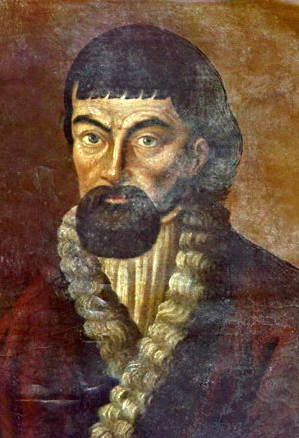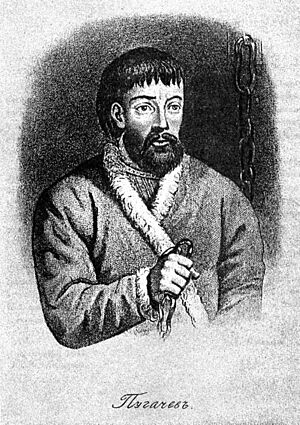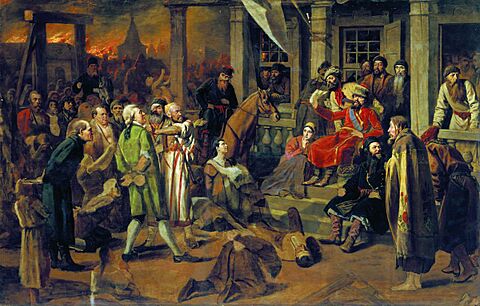Yemelyan Pugachev facts for kids
Quick facts for kids
Yemelyan Pugachev
|
|
|---|---|
| Емельян Пугачёв | |

Portrait by an unknown artist from Simbirsk (1774)
|
|
| Born | c. 1742 present-day Kotelnikovsky District, Volgograd Oblast
|
| Died | 1775 (aged 32–33) |
| Other names | Claimed to be Emperor Peter III |
| Occupation | Leader of a Russian peasant uprising |
Yemelyan Ivanovich Pugachev (also spelled Pugachyov; Russian: Емельyan Ivanovich Pugachyov; born around 1742, died January 21, 1775) was a Cossack leader. He led a huge uprising against the Russian Empire when Catherine the Great was empress. This event is known as the Pugachev's Rebellion.
Pugachev was the son of a Don Cossack landowner. He served in the Russian army during the Seven Years' War and a war against the Ottoman Empire. In 1770, he left the army and became a fugitive. He became popular among peasants, Cossacks, and Old Believers who were unhappy with the government.
In 1773, Pugachev started a rebellion. He claimed to be Emperor Peter III, Catherine's husband, who had died. Pugachev promised to end serfdom, which was a system where peasants were tied to the land. He gathered a large army. His forces quickly took control of a big area between the Volga River and the Urals. In 1774, they captured Kazan and burned the city.
However, in August 1774, General Johann von Michelsohnen defeated the rebels near Tsaritsyn. Soon after, Pugachev was captured by his own Cossacks. They handed him over to the authorities. He was sent to Moscow and executed in January 1775. The famous writer Alexander Pushkin later wrote about this rebellion in his book The Captain's Daughter.
Contents
Who Was Yemelyan Pugachev?
Yemelyan Pugachev was born in a Cossack village called Zimoveyskaya. This area is now part of the Volgograd Oblast. He was the youngest of four children. At 17, he joined the military. A year later, he married Sofya Nedyuzheva. They had five children, but two died when they were babies.
Pugachev joined the Russian army in Prussia during the Seven Years' War. He served under Count Zakhar Grigor'evich Chernyshev. He returned home in 1762. For the next seven years, he split his time between his village and military duties. He was known for his military skills. He reached the rank of khorunzhiy, which is like a company commander.
During the Russo-Turkish War in 1770, he showed a talent for pretending to be someone important. He told his fellow soldiers that his sword was a gift from his "godfather," Peter the Great.
Life on the Run
In 1770, Pugachev asked for time off from the army because he was very sick. He later wanted to leave the army for good. Even though military leaders told him to stay, he refused to be treated in a military hospital. His brother-in-law, Simon Pavlov, convinced him to join some unhappy Cossacks. They were trying to find an independent Cossack community on the Terek River.
After crossing the Don River safely, Pugachev went back home. But the other Cossacks were caught. Pavlov told the authorities that Pugachev was involved in their desertion. This led to Pugachev's arrest. He was held for two days but managed to escape. This was the start of his life as a fugitive, meaning someone who is always on the run.
He went to the Cossack community on the Terek River in early 1772. While there, he joined a group of protesters. They chose him to represent them. On his way to St. Petersburg to make a complaint, he was found out and arrested again. He escaped on February 13 and went home, only to be arrested once more.
He was sent to Cherkassk for questioning. He tricked an official named Lukyan Ivanovich Khudiakov into releasing him. Then, with help from many Old Believers, he fled to Vetka, a town near the Polish border. He returned to Russia in late 1772. He pretended to be an Old Believer who wanted to come home. He got permission to settle in the Malykovka area. It was there that he likely first heard about the Yaik Cossacks rebellion.
The Great Rebellion (1773–1774)
Pugachev thought about pretending to be the late Emperor Peter III early on. This was not surprising, as Russia had a history of people pretending to be important figures, like False Dmitrys.
Pugachev, pretending to be a rich merchant, tested the feelings of the Cossacks at Yaitsk. He suggested they all leave Russia for Turkey. When most of them seemed to agree, he felt it was the right time to start his rebellion.
He was arrested again shortly after and held for five months in Kazan. But he escaped once more. He returned to Yaitsk to begin his revolt. He promised to give the Cossacks back their old rights and to bring back the Old Belief. This helped him gain the support he needed to convince people he was Peter III.
A later story says that Pugachev looked a lot like Tsar Peter III. Peter III had been overthrown and died in 1762. Pugachev told people that he and his main followers had escaped from Catherine.
Pugachev used propaganda and promises of change to build his army. He and his generals took control of a large area between the Volga River and the Urals. Pugachev's biggest victory was taking Kazan. He not only gathered many Cossacks and peasants but also got cannons and weapons. This made his army much stronger than the Russian army expected.
In response, General Petr Ivanovich Panin led a large army against the rebels. But his efforts were slowed by problems with transport, lack of discipline, and his soldiers not obeying orders. Meanwhile, Pugachev's many groups won almost every battle. It wasn't until August 1774 that General Johann von Michelsohnen finally defeated the rebels near Tsaritsyn. In that battle, ten thousand rebels were killed or captured.
After the capture of Penza, General Panin's harsh punishments finished off the rebellion. On September 14, 1774, Pugachev's own Cossacks handed him over to the authorities in Yaitsk. Alexander Suvorov had him sent first to Simbirsk and then to Moscow. On January 21, 1775, Pugachev was executed in Bolotnaya Square in the center of Moscow.
Pugachev's Impact

The Pugachev rebellion had a lasting effect on Russia. Empress Catherine II wanted to make changes to how the provinces were run. But the terrible events of the revolt made her stop other reforms. She especially stopped trying to free the peasant serfs in Russia. The Russian writer Alexander Radishchev wrote a book called Journey from St. Petersburg to Moscow. In it, he criticized the Russian government and the system of serfdom. He mentioned Pugachev and the rebellion as a warning.
The village where Pugachev was born was originally called Zimoveyskaya. After his defeat, its name was changed to Potemkinskaya. But in 1917, after the October Revolution, it was renamed Pugachevskaya in his honor.
The main square in the Kazakh town of Uralsk is named Pugachev Square. There is also a museum dedicated to Yemelyan Pugachev in Uralsk, which opened in 1991.
The rebellion has been shown in books and movies. Alexander Pushkin's 1836 story The Captain's Daughter tells a fictionalized version of the rebellion. This story was partly used for the 1958 film Tempest. The 1928 silent film Bulat-Batyr is also about the Pugachev rebellion.
In the TV show The Great on Hulu, Pugachev is shown as a person who pretends to be Peter III.
See also
 In Spanish: Yemelián Pugachov para niños
In Spanish: Yemelián Pugachov para niños
- Pugachev's Oak
- Pugachev
- False Dmitry I
- False Dmitry II
- False Dmitry III
- Princess Tarakanova
- Romanov impostors


